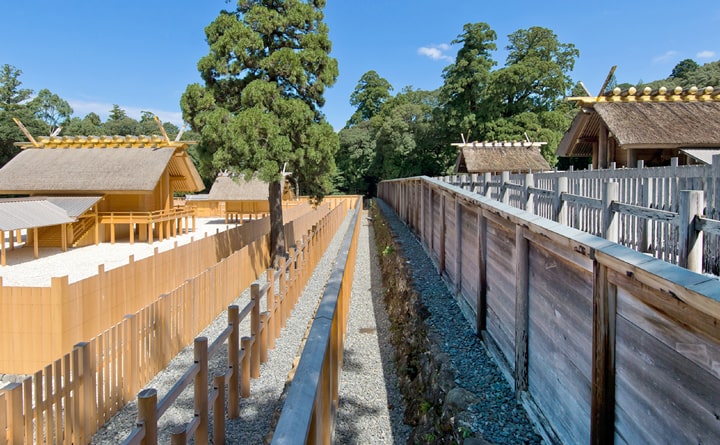Shikinen Sengu
Adjacent to the site where the sanctuary of Amaterasu-Omikami stands is a site of exactly the same size. A new building with the same dimensions as the current one is constructed at this alternate site every twenty years. The divine treasures to be placed inside the sanctuary are also remade. Once they are prepared, the sacred mirror, symbol of Amaterasu-Omikami, is moved to the new sanctuary by the Jingu priests. This ritual is called Shikinen Sengu. It is carried out at Geku and other jinja as well.
The first Shikinen Sengu was conducted 1,300 years ago. Although the Shikinen Sengu tradition was temporarily suspended due to warfare in the 15th and 16th centuries and has sometimes been delayed by a few years, it has continued to be an important part of Jingu to the present day.
Shikinen Sengu involves thirty-three rituals and ceremonies beginning with the ritual cutting of the first trees for the new buildings, and continuing until the transfer of the sacred mirror eight years later.

Wood is central to Japanese civilization. The concepts of sustainability and reutilization, and the maintenance of know-how and skills, are considered more important than the actual physical existence of a structure or building. This is the essence of “eternity” as it is expressed at Jingu, and the reason for choosing to build and rebuild dwellings for the kami, instead of constructing permanent structures of stone.
The forests around Jingu also contribute to the wood resources required for the rebuilding. In the 1920s, Jingu began a program to restore and maintain the forests to supply wood for the Shikinen Sengu, successfully contributing some of the material for the 2013 rebuilding. Presently, the Jingu-owned forest encompasses 5,500 hectares, with the long-term sustainable plan to supply all timber for future Shikinen Sengu ceremonies. Management of this precious wood creates lasting bonds and resilience within the communities involved.
To this day, we are able to participate in the same matsuri our ancestors performed and share a common spirituality with them through the cyclical re-enshrinement of Amaterasu-Omikami. Shikinen Sengu is a temporal and spatial return to origins that spans generations. It resonates with the souls of our ancestors, and is a gift to the future.
Shikinen Sengu plays one other very important role by enabling the transfer of our technical skills and spirit to the next generation. This transfer maintains both our architectural heritage, and over 1,000 years of artistic tradition involving the making of the divine treasures — 714 different kinds of sacred objects. After Shikinen Sengu, the previous sanctuary building is disassembled and most of the timber is granted to other jinja across Japan to be reused. The main pillars that support the roof of the main sanctuaries are traditionally reused for the sacred torii gate on Ujibashi Bridge at the entrance of Naiku.

Glossary
The ancestral kami of the Tenno and the Imperial family
Toyo’uke-daijingu is the Outer Sanctuary where the kami responsible for the food offerings to Amaterasu-Omikami is enshrined.